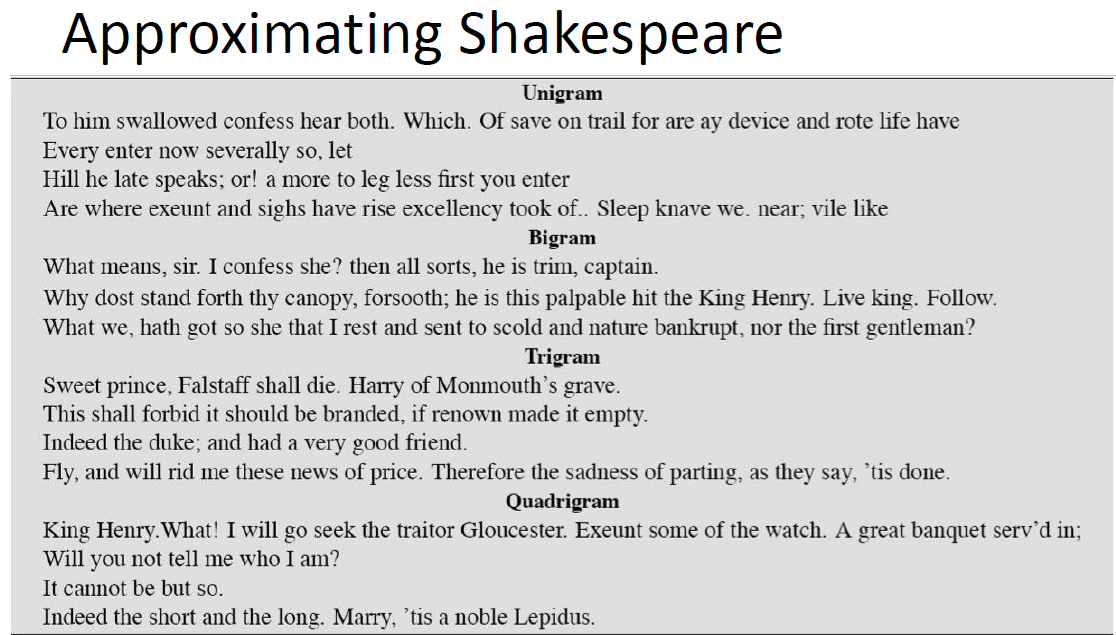Introduction to n-gram language models
How to compute the probability of the next word?
Language Models are defined by the following objective :
- Objective - compute the probability of a sentence or sequence of words. $P(W) = P(w1,w2,w3,…,wn)$
- Related task - computing the probability of the upcoming word. And from this derive the objective. $P(w4|w1,w2,w3)$
Probability of the entire sentence : $P(W) = P(w1,w2,w3…wn)$ = Probability when all the words are happening together in sequence.
P(The, water, of, Walden, Pond, is, so, beautifully, blue) : The probability of when the sentence “The water of Walden Pond is so beautifully blue” will occur in a corpus.
There is a difference between the following -
- Conditional Probability $P(B/A)$ : Probability of B given A : Event B has happened in past. A is happening now. This is known as Conditional Probability.
- Joint Probability $P(A,B)$ : Joint probability of A and B. Or probability when both the events A and B are happening simultaneously.
$P(B/A) = P(A \bigcap B) / P(A)$ or, $P(B/A) = P(A,B) / P(A)$ —– (1) or, $P(A,B) = P(B/A) \times P(A)$
or, $P(A,B) = P(A) \times P(B/A)$ —- (2)
ie. following (2) probability of two events A and B happening together (joint probability) is probability of A multiplied by probability of B when A has already happened. another way to look at it from (1) is that conditional probability is joint probability / porbability of the past event. (see it through the venn diagram way)
- Extending it to multiple events we can write
$P(A, B, C, D) = P(A) \times P(B/A) \times P(C/A,B) \times P(D/A,B,C)$
To get the intuition, following is the chain of thought -
- first the event A happened. So, the probability is P(A) as nothing else has happened now.
- second the event B happened. Event A has already happened in the last step. so the probability of B, we need to compute $P(B/A)$, i.e., probability of B when A has already happened.
- now, the third event C happened. A and B has already happened. So, probability of C would be, $P(C/A,B)$, because A and B has already happened. So,
- now, the fourth event D happened. A, B and C has already happened by now. So, porbability of D when A, B and C has already happened is $P(D/A,B,C)$
- Hence the probability of all the events happening together is $P(A, B, C, D) = P(A) \times P(B/A) \times P(C/A,B) \times P(D/A,B,C)$
Generalizing the above : The objective of a language model is to find - $ P(w_{1:n}) = P(w1) \times P(w2|w1) \times P(w3|w_{1:2}). . . P(w_n|w{1..n-1}) \ = \prod_{k=1}^n(P(w_k|w_{1:k-1})) …………(1) $
Eg : P(“The water of walden pond is so beautifully blue”) = P(The) $\times$ P(water|The) $\times$ P(of|The water) $\times$ P(walden|The water of) $\times$ P(pond|The water of walden) $\times$ P(is|The water of walden pond) $\times$ P(so|The water of walden pond is) $\times$ P(beautifully|The water of walden pond is so) $\times$ P(blue|The water of walden pond is so beautifully)
We will never see enough data for estimating all these probabilities for sure in the corpus. Hence Markov assumption is used to simplify the matter. It states the following -
Markov Assumption of conditional probability P(blue | The water of Walden Pond is so beautifully) ≈ P(blue | beautifully) $P(w_n|w_{1:n-1}) ≈ P(w_n|w_{n-1})$ The approximation is known as bi-gram assumption or 1st order markov assumption. It is considering the probability of $(n-1)^{th}$ word, instead of probability of n-1 words, to determine the Probability of $n^{th}$ word. This is also known as bi-gram assumption or 1st order markov model.
Hence Simplifying the objective function as follows - $P(w_{1:n}) = \prod_{k=1}^n(P(w_k/w_{1:k-1})) ……….(1)$
$P(w_{1:n}) = \prod_{k=1}^n(P(w_k/w_{k-1})) …………(2)$
Generalizing the product term (1) by using “n” instead of “k”. n being nth term, and N being total number of terms. In this case, instead of starting from $1^{st}$ term, we are starting from the $(N)^{th}$ term; the sequence in which the actual probability computations do happen in the language model.
$P(w_{1:n}) = \prod_{k=1}^n(P(w_k|w_{1:k-1})) = \prod_{k=1}^n(P(w_k|w_{k-1})) = \prod_{n=N}^1(P(w_n|w_{(n-(N-1))})) …………(3)$ Here we are using N-1 previous words. (From n to n-(N-1). This is known as n-gram language model.) number of previous words = n = 1 => Unigram model => $∏(P(w_i))$ number of previous words = n = 2 => Bigram model => $∏(P(w_i/w_{n-1}))$
Hence the probability values would give more accurate results when we use more number of previous words. An example of increasing number of previous words -

Counting the probability
$P(w_i|w_{i-1}) = P(w_i,w_{i-1}) / P(w_{i-1})$ — (1) $P(w_i,w_{i-1}) = count(w_i,w_{i-1}) / N — (2) $P(w_{i-1}) = count(w_{i-1}) / N — (3) (2)/(3) = $P(w_i,w_{i-1}) / P(w_{i-1}) = count(w_i,w_{i-1}) / count(w_{i-1})$ $\therefore probability of the next word P(w_i|w_{i-1}) = count(w_i,w_{i-1}) / count(w_{i-1})$
Issues of the n-gram language models which are solved by LLMs
Complexity keeps increasing exponentially
Given a language model that is built with a vocabulary of V, the number of parameters increases exponentially with the increase in number of tokens being looked back for deriving the probability.
- unigram - $V$ parameters to learn
- bigram - $V^2$ parameters to learn
- trigram - $V^3$ parameters to learn
- quadgram - $V^4$ parameters to learn
This is solved by LLMs as they can support much larger contexts, since they use embeddings.
Synonyms and unknown token issues
Since typically the n-gram models use word based tokenization, there are frequent cases where unknown words are encountered. On contrary the large language models use tokenization in the level of sub-words. And then they are vectorized as embeddings, with synonyms and similar words are part of the same context and are nearby each other in the embedding space. That helps solve the synonym and unknown word issue.